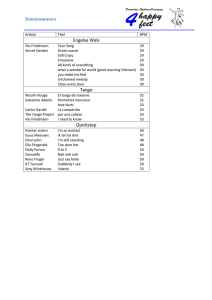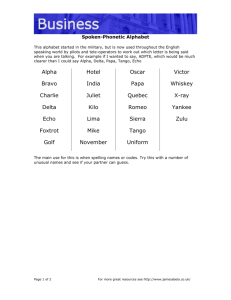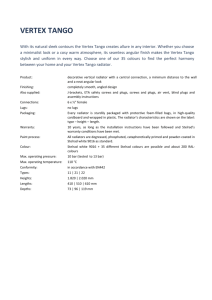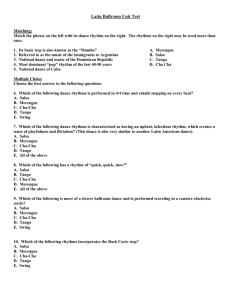Document
advertisement
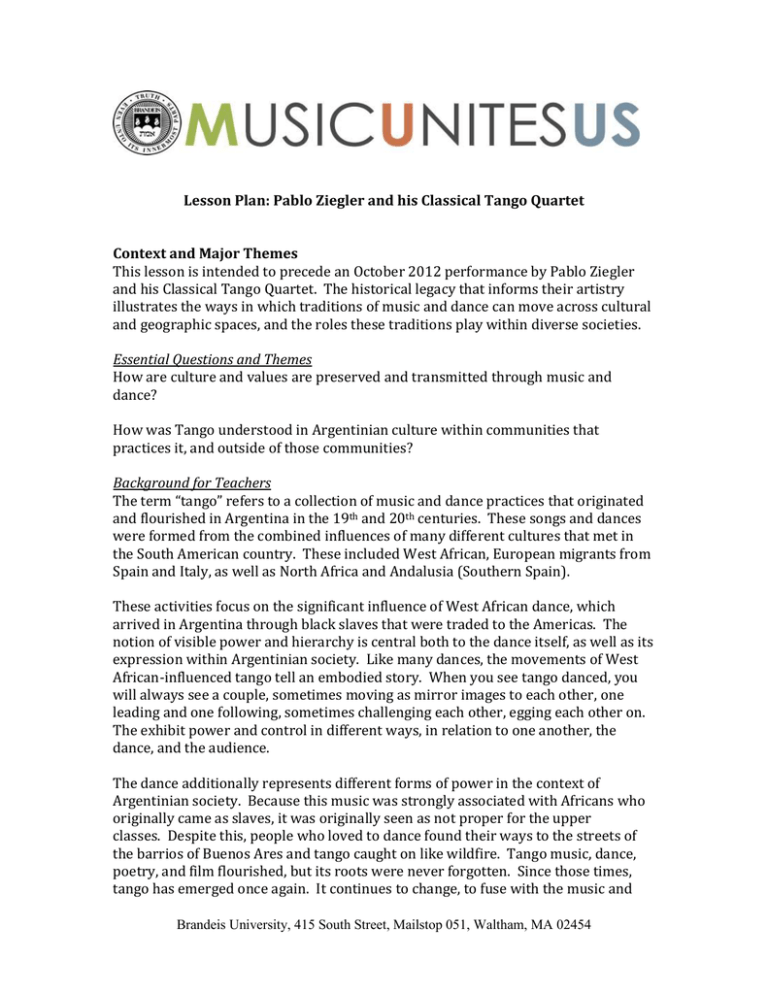
Lesson Plan: Pablo Ziegler and his Classical Tango Quartet Context and Major Themes This lesson is intended to precede an October 2012 performance by Pablo Ziegler and his Classical Tango Quartet. The historical legacy that informs their artistry illustrates the ways in which traditions of music and dance can move across cultural and geographic spaces, and the roles these traditions play within diverse societies. Essential Questions and Themes How are culture and values are preserved and transmitted through music and dance? How was Tango understood in Argentinian culture within communities that practices it, and outside of those communities? Background for Teachers The term “tango” refers to a collection of music and dance practices that originated and flourished in Argentina in the 19th and 20th centuries. These songs and dances were formed from the combined influences of many different cultures that met in the South American country. These included West African, European migrants from Spain and Italy, as well as North Africa and Andalusia (Southern Spain). These activities focus on the significant influence of West African dance, which arrived in Argentina through black slaves that were traded to the Americas. The notion of visible power and hierarchy is central both to the dance itself, as well as its expression within Argentinian society. Like many dances, the movements of West African-influenced tango tell an embodied story. When you see tango danced, you will always see a couple, sometimes moving as mirror images to each other, one leading and one following, sometimes challenging each other, egging each other on. The exhibit power and control in different ways, in relation to one another, the dance, and the audience. The dance additionally represents different forms of power in the context of Argentinian society. Because this music was strongly associated with Africans who originally came as slaves, it was originally seen as not proper for the upper classes. Despite this, people who loved to dance found their ways to the streets of the barrios of Buenos Ares and tango caught on like wildfire. Tango music, dance, poetry, and film flourished, but its roots were never forgotten. Since those times, tango has emerged once again. It continues to change, to fuse with the music and Brandeis University, 415 South Street, Mailstop 051, Waltham, MA 02454 dance around it. Pablo Ziegler is one of the people that has taken this music into the 21st century, carrying on the tradition he learned from older players, composing and playing what is now called “new tango.” Materials Video on CD: (YouTube Linkhttp://www.youtube.com/watch?v=T-VBJkjYIEc&feature=related) Appendix A: Tango Reading Appendix B: Map Worksheet Appendix B: Tango in Visual Art Appendix C: Borrow Words Appendix D: Student Reflection Procedure Warm Up and Close Looking Explain to students that you will be viewing a short video of a man and a woman dancing a tango, though these are not the dancers that will be performing from Brandeis. You may want to start by soliciting student predictions and associations by asking: What do you imagine when you hear the word “tango”? What do you think it will look like? Where do you think these ideas come from? Have you seen anyone dancing the tango before? Explain to students that they will be watching a clip of tango, though these are not the dancers they will see at Brandeis. Watch the first 40 seconds. Stop and ask the students. Who seems to have the power in this pair? Who seems to be in control? How can you tell by their body language? Students may observe, or teacher may guide them to reflect on, the woman’s turned back , hand on hip, etc… but even here what does the turn of her head mean? In there ambiguity? Is it difficult to tell? What do students think the dance will be like, between them? Watch until Minute 1:30 and ask return to the same questions. Is one of them leading the other? Does it look like one of the dancers is in control or has more power? Brandeis University, 415 South Street, Mailstop 051, Waltham, MA 02454 Students may observe, again, that while one dancer is “following” the other, they are also mirroring each other and constantly turning directions, giving the impression of a give-and-take, and an exchange of power. Ask students to reflect on this dynamic. Can they think of other examples showing power moving back and forth? Of an exchange between challenge and response? (Examples might include anything from a presidential debate to a hip hop battle, or a fencing match.) This kind of “performance” appears in many different contexts in many different cultures. Map Activity Ask if students can guess what cultures gave rise to the dance they just saw. Does the music give any clue? (Teacher may want to play another short clip here.) Have students list what parts of the world they might guess and list these predictions on the board. Explain to students that they will check their guesses with a short reading to map the sources of Tango. Pass out Appendix A: Tango Reading and Appendix B: Map Worksheet and have students complete individually or in pairs. Return to the large group and check information from student’s reading and mapping with their predictions. Were they correct? Did the answers surprise them? Why or why not? Visual or Rhetorical Analysis After students have learned that the origins of Tango are in part from the Kingdom of the Kongo in West Africa, the teacher may engage them in one of the two following activities to further explore the dynamic of cultural encounter in Argentina. Visual Analysis Project or provide students with handouts or Appendix C: Tango in Visual Art. Starting with the two paintings by Pedro Figari, the Uruguayan modernist painter, ask students to observe: What would they guess is the setting for this dance? How can they tell? Is it in private or public space? What might the occasion for this dance be? Explain to students that these paintings were done by Pedro Figari in the Barrios (neighborhoods or slums) of Argentina and Uruguay. Because these dances were brought by slaves to the continent they, for a long time, considered part of the lowest class of society. They were performed at events central to the community, such as weddings, parties, and holy days. Brandeis University, 415 South Street, Mailstop 051, Waltham, MA 02454 Next have students look at the Ian Churchill’s sketch of Martin Boneo’s “A Federal Condombe in the Time of the Rosas” and consider the same questions. What is the context for the dance, here? Students may note that here there is an audience. Who is watching? Does it look like this is part of the dance? This sketch shows the Kongo dia Nigunga society perform for President Rosas, the leader of Argentina in 1938. The president is seated with his daughter, watching the performance. Why might this have happened? While dancing such as the Tango that developed from Kongo traditions began as a private activity, relegated to those occupying lower class identities and spaces, other parts of Argentinian soecity became drawn to it. As tango developed it moved in dance clubs and “traditional” dances of Kongo communities became recognized as part of the cultural heritage of the country. There remained, however, a great deal of ambivalence about the dancing and its origins. Tango for many years was present as part of mainstream Argentinian culture, but still kept at a distance. Reflecting on Loan Words In addition to dancing, singing, and art, there are many other ways to explore how cultures “borrow from” and change one another when they come into contact. Language is another example. Ask students if they can guess what a “borrow” word is from another language. Write some examples on the board: What determines which words transfer from one language to another (frequently used, part of daily life, food, etc...) Read through Kongo “borrow words” into Argentina. What can you infer from these about cultural transfer? Wrap-Up From these origins Tango has become a form of art recognized the world over, complete with competitions and performances on some of the world’s most prestigious concert halls. What do students expect they might see and hear at the performance at Brandeis? If time, play a selection from Pablo Ziegler and have students engage in brief response. What words would you use to describe this music? Tango music has been described as: jazzy, dangerous, jagged, smooth, fiery, slinky. Would you use any of these words? Brandeis University, 415 South Street, Mailstop 051, Waltham, MA 02454 Have students write down as many of the instruments as they can. Some they might recognize: accordion, piano, double bass, drums, and guitars. Student Reflection Pass out Appendix D: Student Reflection and review with students to familiarize them with the questions they will be asked to reflect following the performance. Brandeis University, 415 South Street, Mailstop 051, Waltham, MA 02454
